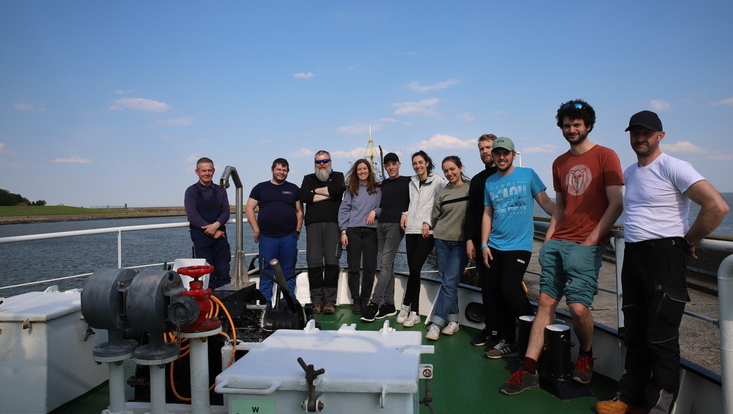With Ludwig Prandtl in Jade Bight
21 December 2023, by Leonie Bauer

Photo: Credit: Yves Sorge
"Jojo-CTDs", "Pütz" measurements, an autonomous catamaran, and even two or three seals - all of this was part of the 2023 sea internship. Here you can find out more about our student measurement trip in May.
We started in Cuxhaven on May 8th with the preparation of the research vessel Ludwig Prandtl. Together we were six students, our lecturers Martin Gade and Niels Fuchs, as well as the crew of the Prandtl, Marco Schaft, Detlef Heinze, and Lars Engelke. In preparation, screens were set up, cookies were bought and three moorings were prepared by attaching devices to them. These were deployed the next day at the predetermined locations and from then on measured the speed and salinity as well as the temperature of the passing current.
Together with other measurements, this was meant to give us information about the water masses in Jade Bight. Acoustic Doppler Current Profiler (ADCP) measurements were also used to observe how the water masses flow in and out of Jade Bight with the tides. This device is part of Ludwig Prandtl's equipment, as are a ferry box and an echo sounder.
After the three moorings had been anchored, we were let loose on the other measuring devices. We were given a short introduction to the correct way to take samples using a water sampler, and to successful CTD measurements. On this day, we also learned how to visualize the data directly on board for the first time.
The first real measurement day started on May 10th. During a phone call with Martina Heinecke from the Helmholtz Center Hereon, we were able to calibrate the Ferrybox properly and finally got started. We defined three stations, each supervised by two people, and then took regular turns. The daily routine consisted of driving "transects", taking water samples, eating cookies while observing surroundings, lowering the CTD into the water, and visualizing data.
We had also defined the transects in advance and based them on the bathymetry of Jade Bight. The two "Chief Student Scientists", who changed every day, came to Marco, the captain, every morning with a daily plan and discussed the planned measurements with him. These mainly consisted of following a transect and stopping for the measurements. Driving transects involves driving along a predefined route at a constant speed. The ADCP device, which runs along the entire time, then measures the velocity profile of this transect. This means that the current velocity distribution over the length of the transect and over the depth can be determined. From this, we later calculated the flow and the volume transport through the various transects. Since we wanted to calculate the transport at different tidal phases, the covering of the transects had to be well-planned.
After the transect had been covered, we usually took a break to take measurements at our three stations. One person noted the time and location of the measurement and then the CTD was lowered and the measurement recorded. The other station consisted of the water sampler, which was used to fill a bottle from the Prandtl laboratory. Lars helped us with this measurement by lowering the water sampler to the desired depth so that we could get a water sample. Another team scooped surface water with a bucket at the "Pütz" (bailer) station. The temperature and salinity of the water were measured and recorded, the data measured by the Ferrybox was also written down and the wind force was measured on the deck of the ship.
The CTD measures the conductivity and temperature of the water, as well as depth and turbidity, and thus allows conclusions to be drawn about different water masses. These can be recognized, for example, by different temperature and salt distributions. This data was also evaluated in our practical report. The day ended with eating wraps together.
On the morning of May 10th, we also visited the Institute for Chemistry and Biology of the Marine Environment (ICBM) in Wilhelmshaven. There we met with Professor Wurl, who showed us the autonomous catamaran "Halobates" from the University of Oldenburg, which can be used to measure exchange processes on the water surface. We then saw Halobates in action the next day. We met at an agreed location and watched Halobates take measurements. Of course, we also took our own, using the Yoyo-CTD measurements, so we had the CTD lowered and raised 10 times.
After another day of measurements on Friday, May 12th, we went back to the moorings on Saturday to get them out of the water. This worked well, but when evaluating the data we found that one of the moorings was tilted for a while due to the strong current. The measurement of the time series could still be evaluated and used. The highlight of the day was a late seal sighting.
On Sunday we said goodbye to Jade Bight and spent the day packing up the measuring equipment, downloading data, and enjoying the view from the bench on deck as we sailed back to Hamburg.
The results of the sea internship were presented in a presentation including a poster session.
Many thanks again to Martin, Niels, Marko, Detlef, and Lars for their support!











